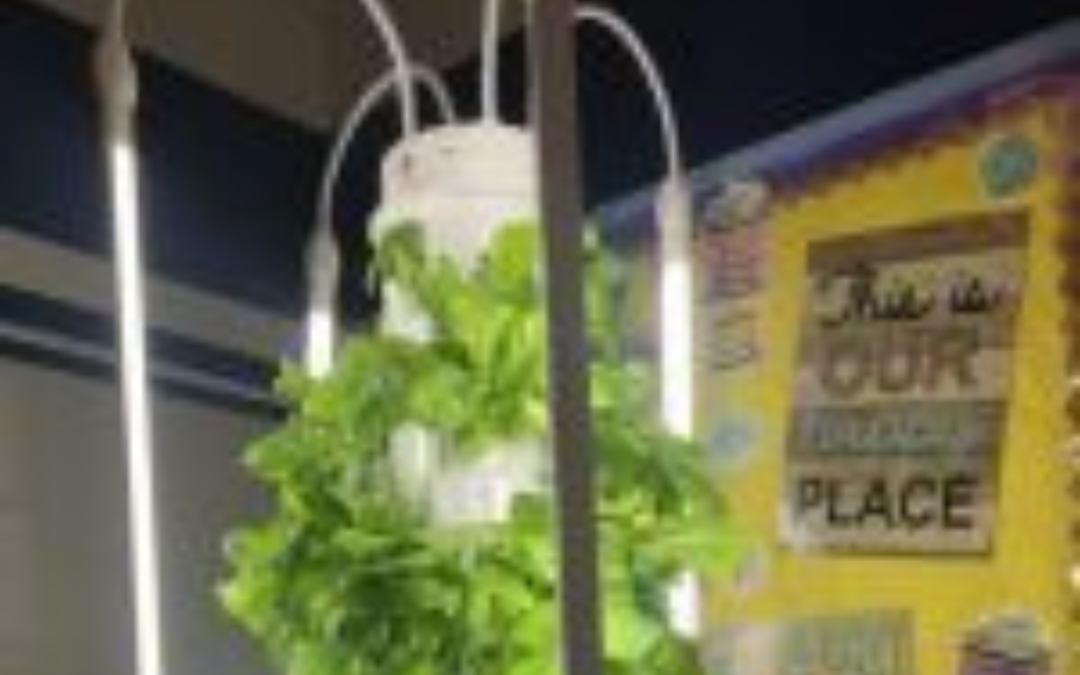By Robin Harkey
This plant researcher girl had a spring in her step donning overalls and a wide-brimmed gardening hat (well, not really) ready to go exploring to visit third-grade teacher, Amber Czapansky, at Rowland Elementary and witness her “Food for Thought” project. Amber’s program was fully funded for $2,000 to purchase two Tower Gardens back in August of 2019 on behalf of the VISD Education Foundation as a part of our Grants for Great Ideas initiative.
Upon entering her room, Czapansky quickly ushered a student to show me the way. “Jacob, take Mrs. Harkey out to the hallway to see our garden. Oh, and grab your science journal.”
Being the noticer I am, I appreciated this super cool Jetson-like six-foot vertical hydroponic garden surrounded by glowing LED lights in a school hallway of all places. Developer Tim Blank, patented his Tower Garden to make plant production space-efficient and adaptable for use anywhere, such as urban rooftops and commercial growing operations. And if you’re flying out of Chicago, you can even find one at the O’Hare Airport.
Proud to be chosen, Jacob did not hesitate as he ran to get his notebook. The confident young boy started our conversion by explaining that Nov. 1, they planted lettuce and basil seed in the classroom into rock wool and transplanted the seedlings into the Tower Garden pods Nov. 12.
When I visited, about a month after that, the 28 plants per tower were erupting out and noticeably larger than if grown in garden soil or potting media. A fact attributed to the hydroponic system that pumps nutrient-rich water up onto the roots of the plants for 15 minutes and then cycles off for 45 minutes for 24 hours.
And because of the optimized lighting programmed to run on a 12-hour on-off cycle. Jacob went on to describe how students were assigned one pod each to observe and measure leaf growth and record their data and make predictions on how much the leaves would grow each week. Jacob then capped off our visit by testing the pH of the growing liquid. To his delight, the pH was spot on with no need for adjustments.
Now that a few months have passed and the students are ready for new challenges, Czapansky plans to teach the children how to cross-pollinate using paintbrushes and continue to explore more vocabulary such as what it means to be “non-genetically modified,” “organic” and how to correct the pH while continuing to develop their data collection and writing skills in alignment with the lesson plans offered by Juice Plus the marketer of the system.
“Seeing kids understand where food comes from, how fresh it can be, and to encourage healthy eating while creating a beautiful environment” is the inspiration for this program, Czapansky quickly commented. “I just love how the kids ooh and aah over it too!”
I was also raving, but over the taste of the fresh basil, I so delicately nibbled. But it doesn’t stop there. The entire school got a chance to sample the food in a salad in the cafeteria during lunch for their “Tower to Table” day. Famous chef, Emeril Lagasse, is known for his fresh food to cafeteria table movement. Hmmmm … this sounds like a fantastic elevated idea for a new grant proposal. (Plus, I would die, absolutely die, to rub shoulders with a big-name professional chef.)
All jokes aside, thank you, Amber, for your dedication to the students at Rowland Elementary. Because of you, hands-on learning is forever planted in these children’s memory banks. Maybe, just maybe, a plant scientist will be born – or a farmer or a teacher or all three.
Only time and attention will tell as kids learn to love learning as they grow to experience more.

